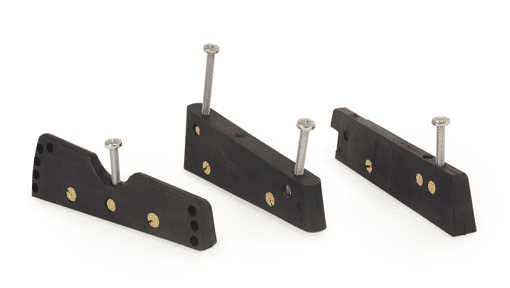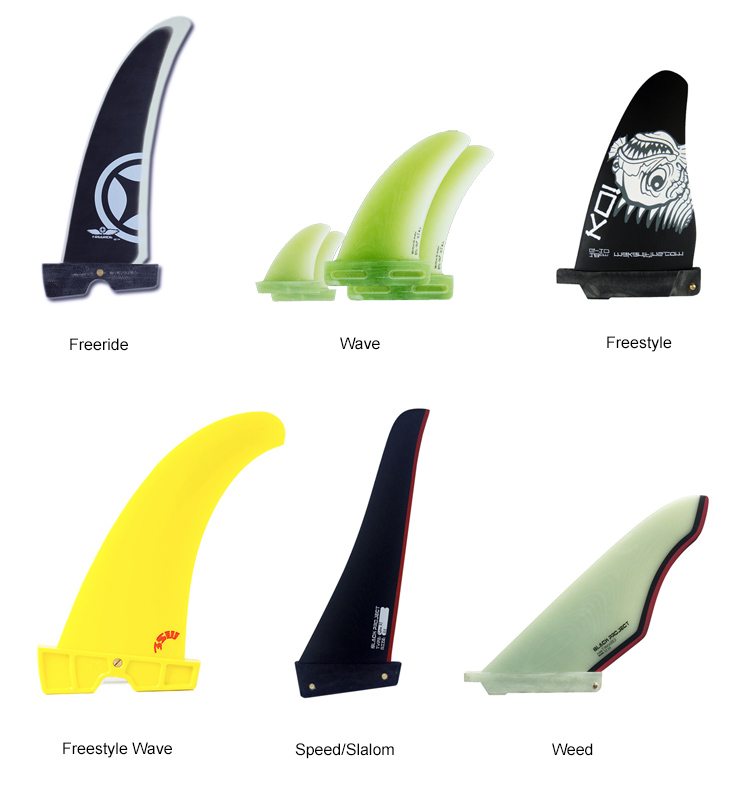Understanding common Windsurf Fin Box types.
Fins are essential components on boards and help to convert the forces provided by wind or paddle into forward motion. They also provide some stability, lift, and sometimes drag. Most importantly, fins work to keep the board on track. Fins are typically made from fiberglass or carbon materials, although some budget options are made of molded plastic. At the base they attach using one of several fin box systems.
There are currently 5 major fin box styles that are in common use today.

The original fin box is the "US Box" aka "American" or sometimes also called a "Chinook Slot". The fin slides into the slot on a pin and is secured with a small plate with a screw. This type was widely used on many older boards. It's most commonly used today on SUP boards (with variations) and some windsurfing wave boards.

Two varieties exist, the "A" box which has a depth of 2.5cm (1"). The other is the "E" (European) box with a depth of 3cm (1.25"). Other variations on SUP boards use different methods to secure the fin in place, some with tools, some without.This is a very compact and lightweight system, often used where there isn't enough depth to use one the other systems.
The "Trim Box" was designed by Bic Sport. It has straight sides with plastic spacers to enable proper positioning of the fin inside the track.
The "Power Box" system was developed and used on F2 and Mistral boards. It has a taper on the sides and on the front and rear. This gives it a very solid fit.
Both he Power Box and the Trim Box were intended for use with 28 - 48cm long fins but could handle fins up to 52cm.
The "Tuttle Box" system is considered to be the strongest fin attachment system. The box has straight sides and a fin base which measures 1.60cm (0.625″) across.
The fit is quite snug in the box and is good for fins up to 58cm long. A common variation is the "Deep Tuttle Box" which is recessed an additional 2cm into the board.
This is a common setup seen today and is strong enough to be adaptable for foiling.
Above: Power Box, Tuttle Box and Trim Box - side by side.
For smaller fins like thrusters or surfboards, there is the FCS box and the Future Box 3/4 and 1/2 tracks. The original FCS uses screws to hold the fin in place. The newer FCS II doesn't require any tools at all. Futures system is very robust with a full length base and is secured with a hex key.
Once you know what box system works with your board then comes the time to select the right size and shape of fin. This will depend on your predominant local riding conditions and also your size, the size of the board and handling preferences. Fins will have different outline shapes, different length, width, the rake angle, and different amounts of flexibility and twist.
It's best to go with recommendations for the type of seasonal riding in your area. Some examples are shown below.

Recent Posts
-
Surfski Paddling in Florida: An overview featuring the latest Epic and Stellar models, Construction Materials, Racing Insights, and Surfski Choices for Fitness Enthusiasts.
Title: Surfski Paddling in Florida: An overview featuring the latest Epic and Stellar models, Cons …23rd Jan 2024 -
A Guide to the Best Windsurf Boards for Beginners
A Guide to the Best Windsurf Boards for BeginnersWould you be surprised to learn windsurfing was inv …21st Jan 2024 -
SERVICING THE NATIVE WATERCRAFT SLAYER PROPEL DRIVE UNIT
SERVICING THE NATIVE WATERCRAFT SLAYER PROPEL DRIVE UNITThe Native Watercraft Slayer Propel Driv …8th Jan 2024




